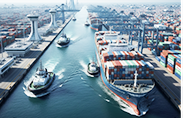If British Columbia won’t bend, let Manitoba open seaport of Churchill
 Canada’s oil export debate has stalled yet again on the Pacific coast, where British Columbia’s reflexive hostility to tankers chokes frustrates Alberta’s producers. Canada’s oil export debate has stalled yet again on the Pacific coast, where British Columbia’s reflexive hostility to tankers chokes frustrates Alberta’s producers.
But while BC digs in its heels, less affluent Manitoba could reawaken the Port of Churchill as a summer oil and gas gateway, and run a purpose-built pipeline from the heart of Alberta’s oil patch across permafrost and muskeg to Hudson Bay.
If Russia can thread the Yamal–Europe line for 4,100 kilometres through shifting Arctic soils, surely Canadians can master a shorter, five-month corridor if it fuels jobs and revenue.
Town and gown in Churchill have long nursed hopeful fantasies of a revitalized port. Locked in ice for half the year, the harbour nevertheless awakens between early July and late November, yielding roughly 145–177 days of navigable water and supposedly expanding climate change peels back the ice sheet.
The Hudson Bay Railway, for all its bouts of flooding and frost-heave damage, now sits under private management and fresh capital injections. Upgraded storage yards and reinforced wharves hint at Churchill’s dormant potential. What it lacks in berth count it makes up for in a direct line to deep international markets - if only oil could flow north instead of rail hauling tiny grain volumes.
The engineering hurdles are real, but far from insurmountable. Canadian pipeline veterans already know how fickle permafrost can be: thaw settlement can buckle warm crude lines, while frost heaves can jack up buried steel.
Muskeg, that water-logged peat sponge, compresses unevenly and belches when disturbed. Yet Russia’s Arctic playbook offers a blueprint. On the Yamal Peninsula - where 80 per cent of Russia’s gas is drawn from permafrost zones - pipelines perch on thermosiphon-cooled pilings.
These passive heat exchangers draw warmth away from the ground, preserving the frozen substrate and guarding against subsidence. Insulated spans and heat-traced sections further isolate buried pipes, while real-time geotechnical labs and satellite surveillance monitor ground movement before it becomes a crisis.
Consider the Yamal–Europe corridor: a 1,420-millimetre steel tube stretching 4,107 kilometres from Bovanenkovo in Siberia to Mallnow in Germany, hauling 33 billion cubic metres of gas annually. Compressor stations and pipeline coatings keep the permafrost intact, even as the tundra around it shifts.
Or look south to the Eastern Siberia–Pacific Ocean (ESPO) oil link: a 4,700-kilometre artery feeding tankers at Kozmino, its pumps and insulation systems fine-tuned to Arctic extremes. When Western nations balked at frontier challenges, Gazprom and Rosneft laid thousands of kilometres of oil and gas lines on frozen ground - and Canada’s own Trans Mountain and Keystone XL corridor designs already borrowed many of the same lessons.
That technical confidence must be matched by political and economic resolve. Manitoba, the country’s third-poorest province by GDP per capita, watches its northern rail lifeline struggle, its grain volumes stagnate and its coffers strain under pandemic-era deficits.
Premier Wab Kinew’s government has flirted with oil-by-rail shipments through Churchill but recoiled from spill risks in muskeg and beluga-teeming estuaries.
Yet if engineered correctly - elevated pipe on driven pilings, geo-textile mats under sensitive spans, horizontal directional drilling beneath creeks - environmental exposure can be managed.
The payoff for Churchill and northern communities would be seismic: docking fees, seasonal stevedoring jobs, renewed rail traffic and a diversified economy impervious to prairie dry spells.
Of course, Manitoba’s regulatory record demands scrutiny. Thirteen pipeline inspections across 5,000 kilometres in five years and 6.5 million litres spilled since 2008 underscore enforcement gaps.
Sceptics will scoff at the notion of tankers threading through the Hudson Bay’s iceberg littered waters. But ice-class crude carriers already haul liquefied natural gas to the Baltic. Thickened hulls, heated ballast tanks and reinforced rudders aren’t pipe dreams - they’re routine in polar trade routes. Churchill’s natural harbour, with minimal tidal range and sheltered anchorage, offers an ideal staging ground. And as climate change tugs at Arctic ice, the shipping window will only widen, cementing Churchill’s role far beyond a one-season stunt.
If British Columbia won’t yield its shores, one must look north, not west. Manitoba is willing to marry Alberta’s oil output with Arctic engineering prowess. By combining winterized pipelines, thermosiphon-cooled foundations and an unbreakable environmental compact, Churchill can illuminate a paradox: the most fragile landscapes can host the world’s toughest infrastructure.
Canada has built early-warning radar lines on polar cap ridges and laid roads through permafrost-scarred valleys. It is likely to prove that, under the long summer sun of Hudson Bay, the oil can find its way to the high seas and world markets. |